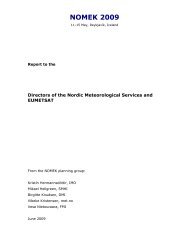International Symposium on Mitigative Measures against Snow ...
International Symposium on Mitigative Measures against Snow ...
International Symposium on Mitigative Measures against Snow ...
You also want an ePaper? Increase the reach of your titles
YUMPU automatically turns print PDFs into web optimized ePapers that Google loves.
<str<strong>on</strong>g>Internati<strong>on</strong>al</str<strong>on</strong>g> <str<strong>on</strong>g>Symposium</str<strong>on</strong>g> <strong>on</strong> <strong>Mitigative</strong> <strong>Measures</strong> <strong>against</strong> <strong>Snow</strong> Avalanches<br />
Egilsstaðir, Iceland, March 11–14, 2008<br />
a) at Ryggf<strong>on</strong>n test stati<strong>on</strong> b) steel reinforced base secti<strong>on</strong> c) tubular shafts (Photo: NGI)<br />
Figure 9: Avalanche towers from Norway.<br />
The study revealed that a singular, tubular steel shaft would be the best opti<strong>on</strong> in the impact<br />
z<strong>on</strong>e of the avalanche core. Factors that influenced this result were:<br />
• Foundati<strong>on</strong> cost is high, thus it is important to minimize the foundati<strong>on</strong> load and<br />
especially the overturning moment.<br />
• All elements located within the impact z<strong>on</strong>e of the avalanche core need to be compact<br />
and able to withstand high local pressure.<br />
• Avalanche directi<strong>on</strong>al variability − Many towers may be subjected to snow avalanches<br />
from opposite hillsides of the valleys, in additi<strong>on</strong> to directi<strong>on</strong>al variati<strong>on</strong>s in a flow from<br />
<strong>on</strong>e hillside.<br />
• It is more ec<strong>on</strong>omical to build str<strong>on</strong>g tower than to build separate protecti<strong>on</strong> structure<br />
uphill, i.e. plow- or wedge.<br />
• Visual impact of transmissi<strong>on</strong> line towers is a matter of importance. Tubular shaft<br />
towers are believed to have a relatively c<strong>on</strong>sistent and good appearance.<br />
• Relative ease of adopting design to variable avalanche loading between tower sites.<br />
From the structural systems investigated during the tender design, a Y-shaped, tubular tower<br />
was selected as it appeared to minimize area exposed to the avalanche loading and thus reduce<br />
overturning moments. This in turn would result in savings for both towers and foundati<strong>on</strong>s.<br />
Brief cost comparis<strong>on</strong>s also indicated ec<strong>on</strong>omical advantages in having the c<strong>on</strong>crete foundati<strong>on</strong><br />
column terminate just above the ground level, as opposed to extend the foundati<strong>on</strong> up to and<br />
above the expected impact z<strong>on</strong>e of the avalanche core. Factored herein was also the relative<br />
speed and simplicity of c<strong>on</strong>structi<strong>on</strong> using tubular steel base secti<strong>on</strong>s as opposed to c<strong>on</strong>crete.<br />
Tower locati<strong>on</strong>s were carefully selected in order to minimize avalanche loading. This further<br />
resulted in having towers in the two lines located essentially side-by-side, as opposed to shifted<br />
al<strong>on</strong>g the line. It was therefore important to maintain sufficient spacing between the parallel<br />
lines such that a tower collapse in <strong>on</strong>e line would not cause damage to the adjacent tower in the<br />
other line. Apart from having to fulfil required electrical clearances above ground, the height of<br />
the towers was also specified such that the average height of the c<strong>on</strong>ductor was maintained<br />
above the saltati<strong>on</strong> layer.<br />
Transmissi<strong>on</strong> lines in avalanche areas are at times designed with all towers as dead-end<br />
structures (i.e. no suspensi<strong>on</strong> tower) to minimize damage of adjacent towers if <strong>on</strong>e tower fails.<br />
172 Towers for snow avalanches in 420 kV transmissi<strong>on</strong> lines in Iceland











